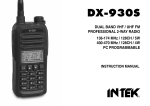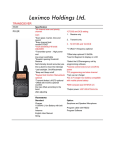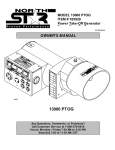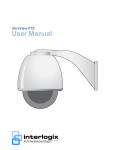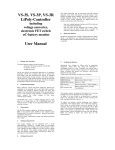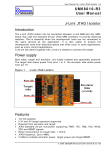Download Max-728 user manual
Transcript
Max-728 VHF/UHF Transceiver User Manual PRECAUTIONS ·Refer service to qualified technicians only. ·Do not operate the transceiver nor charge a battery pack in an explosive atmosphere (gases, dust, fumes, etc.). ·Turn OFF the transceiver while taking on fuel or while parked in a gasoline service station. ·Do not modify nor attempt to adjust this transceiver for any reason. ·Do not expose the transceiver to long periods of direct sunlight, nor place it close to heating appliances. ·Do not place the transceiver in excessively dusty, humid, and/or wet areas, nor on unstable surfaces. SAFETY: It is important that the operator be aware of and underst and hazards common to the operation of any transceiver. CONTENTS UNPACKING AND CHECKING EQUIPMENT Supplied Accessories----------------------------------------------1 PREPARATION Charging the Battery Pack---------------------------------------2-3 Installing/Removing the Battery Pack---------------------------4 Installing the Antenna----------------------------------------------5 Installing the Belt Clip---------------------------------------------5 Installing the Cover over the Speaker / Microphone Jacks----6 Installing the Speaker/ Microphone------------------------------6 GETTING ACQUAINTED---------------------------------------7 OPERATION--------------------------------------------------------8 AUXILIARY FUNCTIONS Time-out Timer-----------------------------------------------------9 Battery Saver--------------------------------------------------------9 Low Battery Warning Monitor------------------------------------9 CTCSS/DCS CODES 50 CTCSS frequency codes (Hz)----- ---------------------------10 104+1 DCS codes--------------------------------------------------10 TROUBLESHOOTING GUIDE---------------------------------11 FREQUENCY CHART-------------------------------------------12 ADVANCED OPERATIONS Safety Training Information--------------------------------------13 Electromagnetic interference / Compatibility------------------14 P1 UNPACKING AND CHECKING EQUIPMENT Carefully unpack the transceiver. We recommend that you identify the items listed in the following table before discarding the packing material. If any items are missing or have been damaged during shipment, file a claim with the carrier immediately. Supplied Accessories ITEM QUANTITY Antenna 1 Battery charger 1 AC adaptor 1 Battery pack 1 Belt clip 1 Instruction manual 1 P2 PREPARATION Charging the Battery Pack The battery pack is not charged at the factory; charge it before use. Initially charging the battery pack after purchase or extended storage (greater than 2 months) will not bring the battery pack to its normal operating capacity. After repeating the charge/discharge cycle two or three times, the operating capacity will increase to normal. CAUTION DO NOT RECHARGE THE BATTERY PACK IF IT IS ALREADY FULLY CHARGED. DOING SO MAY CAUSE THE LIFE OF THE BATTERY PACK TO SHORTEN OR THE BATTERY PACK MAY BE DAMAGED. AFTER RECHARGING THE BATTERY PACK, DISCONNECT IT FROM THE CHARGER. CHARGING THE BATTERY PACK FOR MORE THAN 5 DAYS MAY REDUCE THE BATTERY PACK LIFE. Note The ambient temperature should be between 41 and 104°F (5 and 40 ) while charging is in progress. Charging outside this range may not fully charge the battery. Always switch OFF the transceiver equipped with a battery pack before charging. Using the transceiver while charging its battery pack will interfere with correct charging. The battery pack life is over when its operating time decreases even though it is fully and correctly charged. Replace the battery pack. P3 Plug the AC adaptor cable into the adaptor jack located on the rear of the charger. Plug the AC adaptor into an AC outlet. Slide the battery pack or transceiver with a battery pack into the charger. Make sure the battery pack contacts are in contact with the charging terminals. The charger LED lights and charging begins. After charging the supplied battery pack for 4 hours, remove it or the transceiver equipped with it from the charger. The charger turn to green automatically after charging is completed. Unplug the AC adaptor from the AC outlet. P4 Installing / Removing the Battery Pack The average life of the supplied battery pack is 12 hours. Average times are calculated using 5% transmit time, 5% receive time, and 90% standby time. CAUTION DO NOT TAMPER WITH THE BATTERY TERMINALS NOR DISPOSE OF THE BATTERY BY FIRE. NEVER ATTEMPT TO REMOVE THE CASING FROM THE BATTERY PACK. To remove the battery pack, pull back on the release latch and slide the pack away from the transceiver. Slide the battery pack along the back of the transceiver. Match the bottom of the battery pack with the corresponding grooves on the back of the transceiver. P5 Installing the Antenna Screw the antenna into the connector on the top of the transceiver by holding the antenna at its base and turning it clockw-ise until secure. Note: The antenna is neither a handle, a key ring retainer, nor a speaker/microphone attachment point. Using the antenna in these ways may damage the antenna and degrade your transceiver's performance. Installing the Belt Clip If necessary, buckle the belt clip to the back of the battery pack. Note: Make sure the battery pack contacts are in contact with the charging terminals. The charger LED lights and charging begins. CAUTION DO NOT USE GLUE WHICH IS DESIGNED TO PREVENT SCREW LOOSENING WHEN INSTALLING THE BELT CLIP,AS IT MAY CAUSE DAMAGE TO THE TRANSCEIVER. ACRYLIC ESTER, WHICH IS CONTAINED IN THESE GLUES, MAY CRACK THE TRANSCEIVER'S BACK PANEL. P6 Installing the Cover over the Speaker/ Microphone Jacks If you are not using a speaker / microphone, install the cover over the speaker /microphone jacks using the supplied screw. Note: To keep the transceiver water resistant, you must cover the speaker / microphone jacks with the supplied cover. Installing the Speaker/ Microphone If you are not using a speaker / microphone, install the cover over the speaker / microphone jacks. Note: To keep the transceiver water resistant, you must cover the speaker / microphone jacks with the supplied cover. P7 GETTING ACQUAINTED Notices: Side button 2 and side button 3 can be programmable by PC software to these functions: Monitor, Squencl on/off, Scan on/off, Scan temperary delete, High/Low power, Talk about, Reverse frequency, VOX on/off, Scrambler on/off. Above functions can be programmable through short press or long press at side button 2 and side button 3. Those functions can be programmable through PC softare: Tx total time (s), Squelch, Voice annunciation, VOX gain level, Band width, Tx power rank,Beep, scrambler. P8 OPERATION Switch ON the transceiver by turning the Power switch / Volume control clockwise. A beep sounds Adjust the volume by pressing and holding the Monitor key, then rotating the Power switch / Volume control. Rotate the Channel selector to select your desired channel. When you receive an appropriate signal, you will hear audio from the speaker.’ To make a call, press and hold the PTT switch; then, speak into the microphone using your normal speaking voice. Hold the microphone approximately 1.5 inches (3 to 4 cm) from your lips. Release the PTT switch to receive. Note: When the battery pack voltage becomes too low, transmisson will stop and the LED will blink red. See "Low Battery Warning" on page 9. P9 AUXILIARY FUNCTIONS Time-out Timer The purpose of the Time-out Timer is to prevent any single person from using a channel for an extended period of time. If you continuously transmit for 300 seconds, the transceiver will stop transmitting and a tone will sound. To stop the tone, release the PTT switch. You can press the PTT switch again to resume transmitting. Battery Saver The Battery Saver function decreases the amount of power used when a signal is not being received and no operations are being performed (no keys nor switches are being pressed). While the channel is not busy and no operation is performed for 10 seconds, Battery Saver turns ON. When a signal is received or an operation is performed, Battery Saver turns OFF. Low Battery Warning Low Battery Warning alerts you when the battery needs to be recharged. While transmitting, if the battery power goes below a predetermined value, the LED will blink red. When a tone sounds, the transceiver stops transmitting. Replace or recharge the battery pack. Monitor When no signals are present, the squelch on the transceiver automatically mutes the speaker so you will not hear background noise. To manually deactivate the squelch, press and hold the Monitor key. This is useful when you want to adjust the volume level or when you need to hear a weak signal. The LED indicator lights green while the Monitor key is pressed. P10 P11 P12 P13 ADVANCED OPERATIONS Safety Training Information WARNING Your radio generates RF electromagnetic energy while in transmit mode. This radio is designed for and classified as "Occupationa Use Only", meaning it must be used only by individuals aware of the hazards and the ways to minimize such hazards. This radio is NOT intended for use by the "General Population". Caution To ensure that your exposure to RF electromagnetic energy is within the allowable limits for occupational use, always adhere to the following guidelines: DO NOT operate the radio without a proper antenna attached, as this may damage the radio and may also cause you to exceed RF exposure limits. A proper antenna is the antenna supplied with this radio by the manufacturer or an antenna specifically authorized by the manufacturer for use with this radio. DO NOT transmit for more than 50% of total radio use time ( "50% duty cycle"). Transmitting more than 50% of the time can cause RF exposure compliance requirements to be exceeded. The radio is transmitting whe the "TX indicator" lights red. You transmit by pressing the "PTT" switch. ALWAYS use authorized accessories (antennas, batteries, belt clips, speaker/mics, etc). Use of unauthorized accessories can cause the RF exposure compliance requirements to be exceeded. ALWAYS keep the antenna at least 2.5cm (1 inch) away from the body when transmitting and use only the provided clips when attaching the radio. P14 Electromagnetic interference / Compatibility During transmissions, your radio generates RF energy that can possibly cause interference with other devices or systems. To avoid such interference, turn off the radio in areas where signs are posted to do so. DO NOT operate the transmitter in areas that are sensitive to electromagnetic radiation such as hospitals, aircraft, and blasting sites. We hope your Max-728 Transceivers will provide years of trouble free operation! The Maximon Team

















